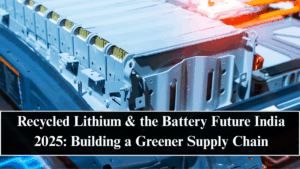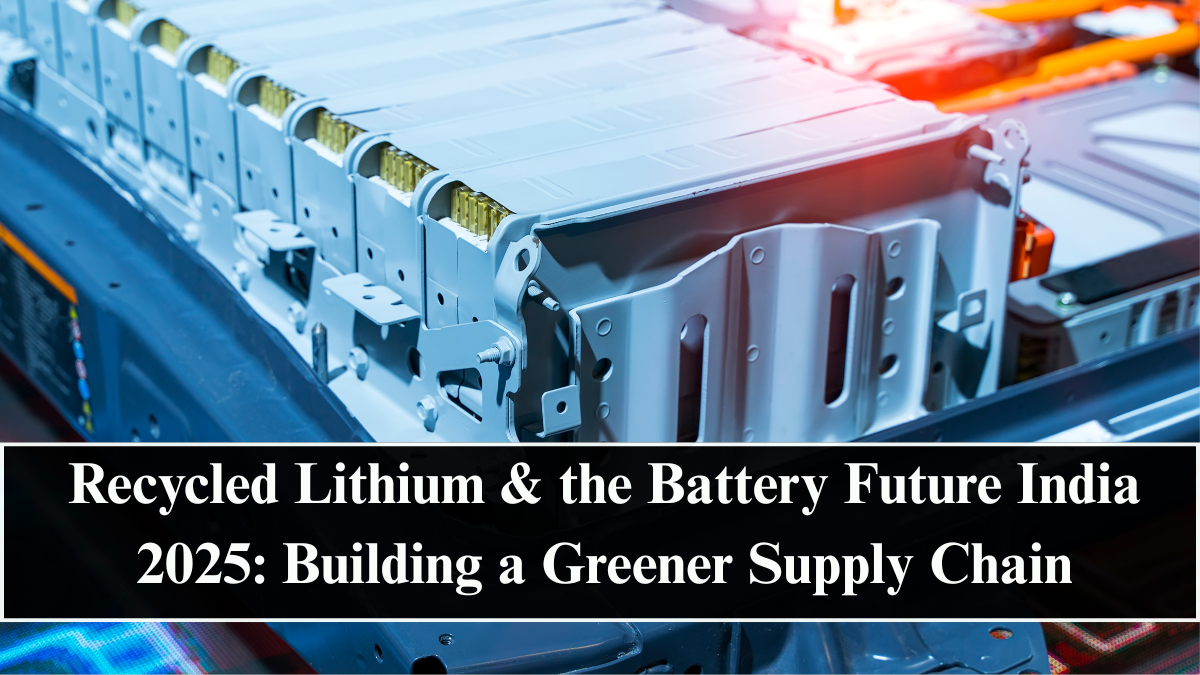India’s EV boom has created an equally critical challenge — managing the growing volume of used batteries and their rare materials. With Recycled Lithium Battery Materials India 2025, the nation is entering a new phase of sustainable innovation, where circular battery economics are turning waste into valuable resources.
By recovering lithium, nickel, cobalt, and manganese from spent batteries, India is building a closed-loop battery ecosystem that supports domestic EV manufacturing while cutting dependence on costly imports.

Why Lithium Recycling Matters
As EV adoption surges, so does the demand for lithium — the key ingredient in electric mobility. India’s battery demand is expected to exceed 150 GWh by 2030, yet domestic lithium reserves remain limited.
Recycling used batteries provides a sustainable alternative, offering multiple benefits:
-
Resource recovery: Extracting valuable metals like lithium, cobalt, and nickel.
-
Environmental protection: Reducing hazardous battery waste and pollution.
-
Energy savings: Recycling lithium uses 40–50% less energy than mining new ore.
-
Cost reduction: Cutting production costs for EV batteries through material reuse.
For a country aiming for EV self-reliance under the Atmanirbhar Bharat Mission, lithium recycling is not just sustainable — it’s strategic.
The State of India’s Battery Recycling Industry
In 2025, India’s battery recycling market is valued at over $1.2 billion, growing at an annual rate of 25%. Several key players — including Attero Recycling, Lohum Cleantech, Exigo Recycling, and Gravita India — are pioneering lithium recovery and closed-loop processing facilities.
Companies are setting up large-scale plants with hydrometallurgical and direct recovery technologies, capable of extracting up to 90% of lithium content from used cells.
Government partnerships under the PLI Scheme for Advanced Chemistry Cells (ACC) are fueling innovation, offering incentives for recyclers to integrate recovered materials into fresh battery production.
Technology Behind Battery Recycling
Modern battery recycling relies on advanced extraction and refining techniques:
-
Mechanical Shredding: Separates battery casings, electrodes, and electrolytes.
-
Hydrometallurgy: Uses chemical leaching to dissolve metals for recovery.
-
Pyrometallurgy: Involves high-temperature smelting to separate valuable elements.
-
Direct Recycling: Restores active cathode materials for reuse without complete breakdown.
Indian firms are also experimenting with AI-powered battery diagnostics to identify which components are most reusable, ensuring minimal wastage and maximum recovery.
Circular Economy in Action
The transition to a circular battery economy means used EV batteries are no longer waste — they are raw material for the next generation of energy storage.
Once collected, old lithium-ion batteries are:
-
Tested and graded based on remaining capacity.
-
Repurposed for stationary storage (solar, grid balancing).
-
Recycled to recover lithium and other materials for new battery packs.
This loop reduces dependency on international suppliers like China and Chile, while strengthening India’s domestic battery value chain.
Policy and Regulatory Support
India’s Battery Waste Management Rules 2022 mandate that producers and importers ensure collection, recycling, or repurposing of used batteries. Under Extended Producer Responsibility (EPR), EV manufacturers must now partner with authorized recyclers for material recovery.
Incentives from FAME-II and PLI-ACC schemes are further encouraging local recycling startups to expand capacity, ensuring India builds a self-sustaining ecosystem for battery lifecycle management.
The Road Ahead: From Waste to Wealth
By 2025, Recycled Lithium Battery Materials India has become a pillar of the nation’s green mobility vision. The next frontier lies in integrating AI-driven recycling plants, advanced material tracking via blockchain, and urban mining networks for efficient collection.
With lithium reserves limited but innovation limitless, India’s recycling revolution ensures every used battery becomes a resource — closing the loop between consumption and conservation.
As India electrifies its roads, the future of energy lies not in what’s mined — but in what’s recovered, reused, and reborn.
FAQs
Why is lithium recycling important for India?
It helps recover valuable materials, reduces environmental pollution, and minimizes dependency on imported raw materials.
Which companies are leading lithium recycling in India?
Attero Recycling, Lohum Cleantech, Gravita India, and Exigo Recycling are among the top players in 2025.
What technologies are used in battery recycling?
Hydrometallurgy, pyrometallurgy, and direct recycling are the primary processes for metal recovery from used batteries.
How do government policies support lithium recycling?
The Battery Waste Management Rules and PLI-ACC schemes incentivize manufacturers and recyclers to create a closed-loop supply chain.
What is the future of recycled battery materials in India?
India aims for a fully circular battery economy by 2030, where most new EV batteries are made using recovered and recycled materials.
Click here to know more.
